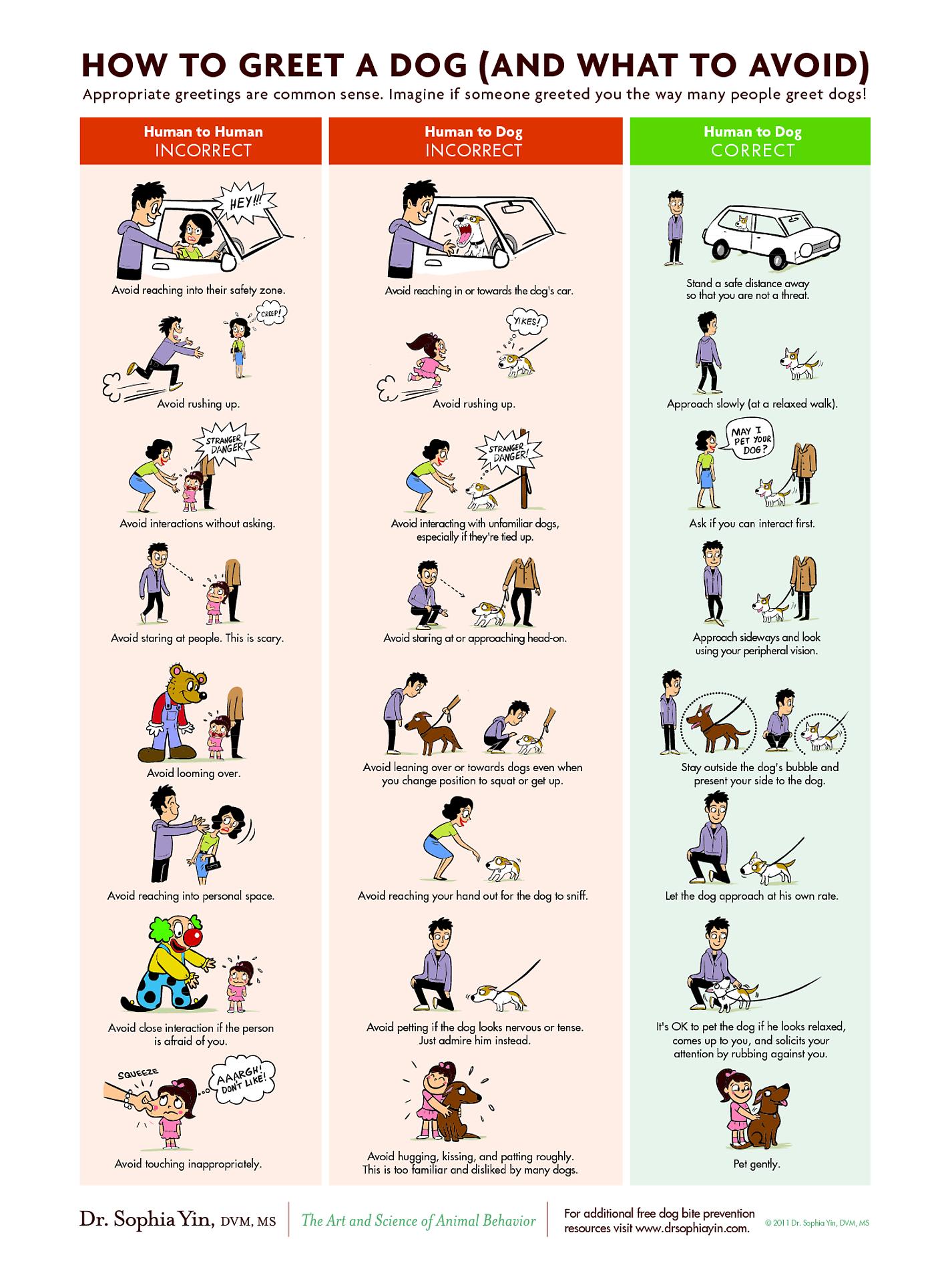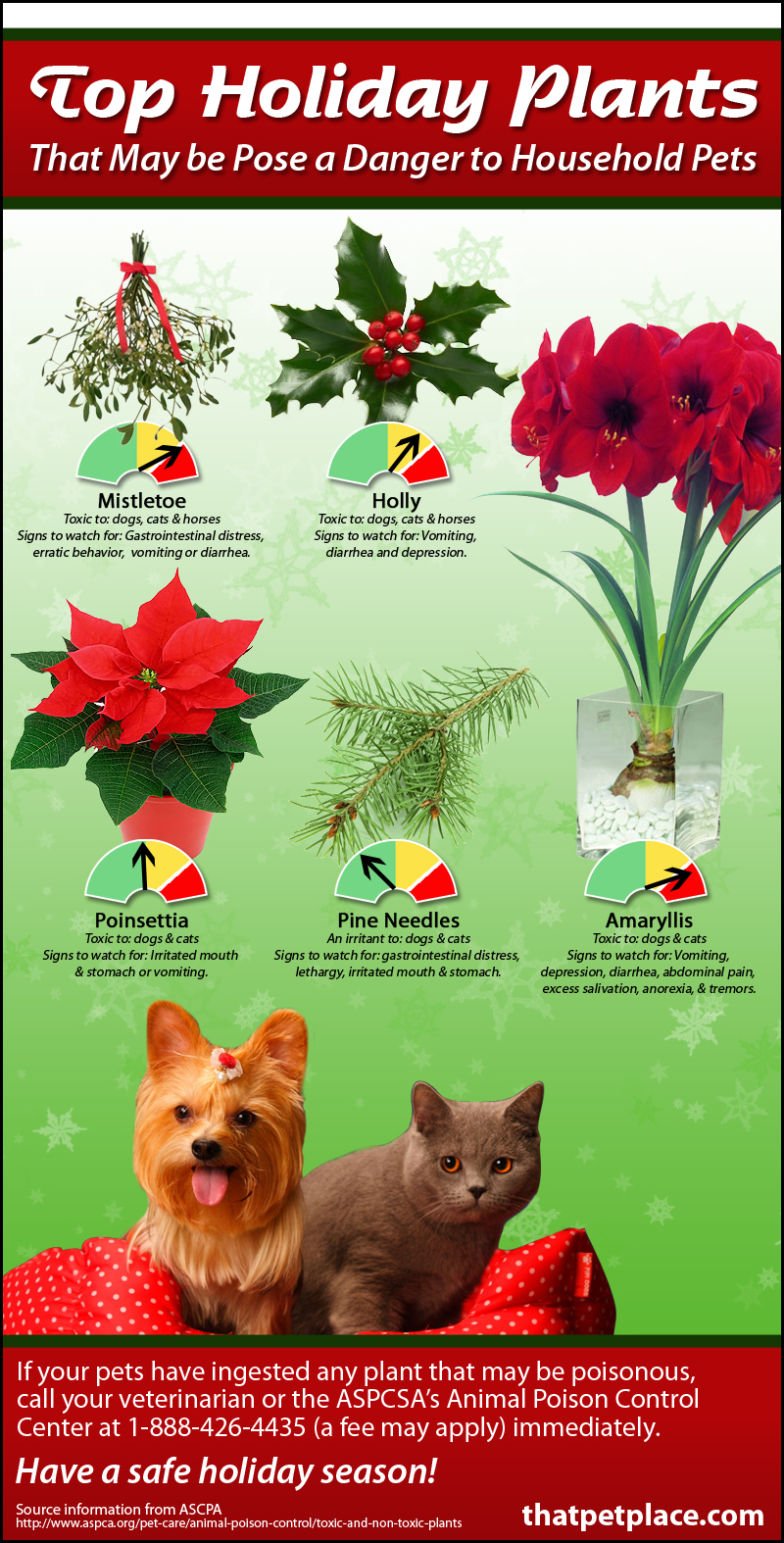You know that feeling you get every time you see a new dog? That somewhat uncontrollable urge to run over scoop that pup up and snuggle it for hours. As tempting as it may be, think about it from the dog’s point of view, scary right? If a dog sees you as a threat they may feel like they have no choice other than to bite. Here are some tips on how to greet dogs in a non-threatening manner.
Category Archives: Pet Safety
Feed Subscription8 ways to exercise your dog indoors
Just like us our pets can pack on a few extra pounds over the cold months. Here are some tips to help keep your dogs active as the temperatures drop.
![stockxpertcom_id100161_size0[1]](http://www.thatpetblog.com/wp-content/stockxpertcom_id100161_size01-300x189.jpg)
- Hide some of your dogs favorite treats around the house and put his natural instincts to work sniffing them out.
- Visit your local pet store for some socialization and a long walk through the aisles.
- Most human treadmills can be utilized for K-9 family members too. Make sure to take time to train you dog safely to use a treadmill, and never leash your pet to the treadmill.
- Play fetch with an indoor safe toy like the Chuck-It indoor roller. Add a little extra to the work out by throwing the ball up the steps!
- Make meal time more fun and stimulating with some interactive puzzle toys!
- Create an indoor agility course for your pup out of things around your house.
- Have a play date with one of your dogs 4legged buddies.
- Rotate your dogs toys so he stays interested and doesn’t get bored.
Pet Microchipping – 5 Reasons You Should Have Done it Already
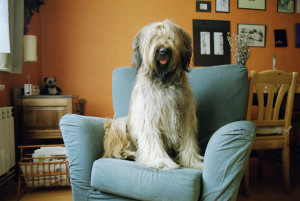 There’s nothing worse than losing a loved one. Let alone a loved one who doesn’t have a cell phone or really any clue on how to find their way back to the family they love. Unfortunately, that’s the reality you’re facing ever time your 4-legged friend hits the ground running outside. If you were to step back and ask the question – what can I do to offer the best chance that my pet finds his way back home in an emergency – and sure, not spend a ton of money in the process – your answer would be microchipping. So – without further delay – let’s look at 5 Reasons why you should have already microchipped your four-legged friend.
There’s nothing worse than losing a loved one. Let alone a loved one who doesn’t have a cell phone or really any clue on how to find their way back to the family they love. Unfortunately, that’s the reality you’re facing ever time your 4-legged friend hits the ground running outside. If you were to step back and ask the question – what can I do to offer the best chance that my pet finds his way back home in an emergency – and sure, not spend a ton of money in the process – your answer would be microchipping. So – without further delay – let’s look at 5 Reasons why you should have already microchipped your four-legged friend.
1. It’s a Lifetime Safety Net For Your Pet’s Security
You can’t really say that about anything else! Microchips are permanently embedded in your pet’s skin and made to last 25 years. That’s longer than any collar or tag, and it’s not about to fall off when your little escape artist crawls under that chain-link fence. The American Humane Association estimates over 10 million dogs and cats are lost or stolen every year – make sure you and your loved ones are prepared.
2. It Doesn’t Hurt Much
Your pet is used to vaccinations – and microchipping feels similar. Your veterinarian will simply use a needle to insert a small, grain-sized chip between your pet’s shoulder blades. A shot for a lifetime of security is a fair tradeoff.
3. Microchipping Works – We Have the Stats to Prove It
The American Veterinary Medical Association conducted a survey that said stray dogs at shelters WITHOUT a microchip were returned to their owners 21.9% of the time. That number increased to 52.2% when the dog was microchipped. To put that another way – it went from a 1 in 5 chance to greater than a 1 in 2. Similarly, cats without microchips were only returned 1.8% of the time, while cats WITH microchips were returned an amazing 38.5% of the time. Again, a 1 out of 50 chance changed to a 1 in 3. Microchipping has been so successful, that both England and Scotland have recently made it mandatory.

4. It’s Inexpensive
Compared to the other costs associated with owning a dog a microchip is barely an expense at all. In fact, many animal rescues, clinics, pet stores and veterinarians offer low-cost microchipping services all of the time. Not to put a cost on a lifetime of security and peace of mind, but you’re really only looking at $10 to $40 dollars per animal. In addition, though you should check the chip from time-to-time, they do not require batteries and have a lifespan of 25 years. This means there’s little to no upkeep cost. Awesome!
5. There’s No Better Feeling Than The Love Of An Animal!
As if you needed any more encouragement – here are a few amazing videos of pets being returned to their owners because of microchipping. Warning – you may want to have tissues handy!
Sources & Resources
https://www.avma.org/KB/Resources/FAQs/Pages/Microchipping-of-animals-FAQ.aspx
https://www.petfinder.com/dogs/lost-and-found-dogs/why-microchip/
Need to find a veterinarian near you to get your pet microchipped? – check out – https://www.aaha.org/pet_owner/about_aaha/hospital_search/default.aspx
Water Safety Tips for Pet Owners
Summertime is full of opportunities for most of us to get out and enjoy the beautiful weather. But as we all know, that searing summer sun can be intense and in the search for some reprieve we often find ourselves poolside, in local stream, river, lake, or on the beach. If you’re like me, you likely have your pet along too. My pup is a water-lover; if there is a way for her to get wet she will be. While it’s always fun having her along to play or go for a swim, it’s also important to keep any pet’s safety in mind while on, in, or near water. Here are some things to keep in mind as you splash through summer with your favorite four-legged companion.
Does Your Pet Like The Water?
The first thing to think about (especially if this is the first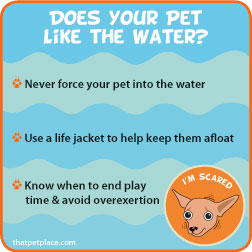 season you’ll be taking your pet in or near water) is that not all pets can swim, swim well, or want to swim. While some dogs seem like they were born to swim and take to it immediately, others struggle with fear of the water, panic in the water, or even find themselves in peril due to their own physiology. In my experience, toy breeds tend to be less than enthusiastic about water. I’m sure there are exceptions to my observations, but in general they have no interest and may even tremble at the sight. Likewise, breeds and mixes with thick bodies, short legs, cropped/short tails, and short snouts are prone to being terrible swimmers. Though they may be interested in swimming, you may find that it just doesn’t work out for them without a little help and constant supervision. You may consider purchasing a life vest to help to keep your pet afloat. Never force your dog into the water. Allow them to approach and investigate on their own under close supervision. If he or she seems anxious or scared, water play may not be for your pet, and taking them into the water may only increase that fear or anxiety. Some pets like to take a quick dip, others may stay in the water all day if you let them. You can usually tell when it’s time to take a rest just by the way your pet is holding himself. Know when it’s time to wrap up play time, especially when the temperatures soar to avoid over exertion.
season you’ll be taking your pet in or near water) is that not all pets can swim, swim well, or want to swim. While some dogs seem like they were born to swim and take to it immediately, others struggle with fear of the water, panic in the water, or even find themselves in peril due to their own physiology. In my experience, toy breeds tend to be less than enthusiastic about water. I’m sure there are exceptions to my observations, but in general they have no interest and may even tremble at the sight. Likewise, breeds and mixes with thick bodies, short legs, cropped/short tails, and short snouts are prone to being terrible swimmers. Though they may be interested in swimming, you may find that it just doesn’t work out for them without a little help and constant supervision. You may consider purchasing a life vest to help to keep your pet afloat. Never force your dog into the water. Allow them to approach and investigate on their own under close supervision. If he or she seems anxious or scared, water play may not be for your pet, and taking them into the water may only increase that fear or anxiety. Some pets like to take a quick dip, others may stay in the water all day if you let them. You can usually tell when it’s time to take a rest just by the way your pet is holding himself. Know when it’s time to wrap up play time, especially when the temperatures soar to avoid over exertion.
Other conditions may also make it hard for pets to partake in water activities. Small dogs and dogs with little or no fur can become cold quickly, even in warmer water. Older dogs and dogs with pre-existing heart, joint, ear or skin conditions could have flare-up after going for a swim.
Check Your Surroundings
My pet and I tend to seek out freshwater rivers, streams, and lakes to cool off. When you take your pet somewhere
and lakes to cool off. When you take your pet somewhere
to swim (no matter where) be sure to look around the area. Posted signs such as “no swimming” signs should not just apply to you, but to your pet as well as there may be unseen safety hazards. Avoid bodies of water that smell bad or may be prone to farm waste, roadway runoff or other contaminants that may be harmful to you or your pet. Also be aware of potential hazards in the shallows or on the shore such as broken glass, fishing line/hooks, sharp rocks or branches, and other potential hazards. Be sure the area you choose has slow current and areas where he or she can reach the bottom or the shore easily to take a breather.
If you live near the coast, you may be lucky enough to take your dog to the beach for playtime. It’s particularly important to pay attention to wildlife and water condition warnings at these locations. Strong tides, waves and undercurrents can pull your pet under or carry them out into deeper water. Jellyfish and other sea life (such as toxic pufferfish), alive or dead, may be washed onto the shore and can make a pet sick or inflict other injuries.
Boat Safety
Some pet owners even take their pets boating. Pets should 
be acclimated to traveling on watercraft before you embark.
The motion of the water rocking the boat may cause them to feel unstable and nauseated and it may cause nervousness and anxiety. The sound of the boat motor may also frighten some pets, so make sure your pet isn’t alarmed when the motor is started or changes pitch. Once they’re accustomed to the new sounds and sensations, be sure to observe the same boat safety for your dog as you do for yourself and other passengers. Invest in a pet life jacket in case your pet jumps or falls overboard. Keep tackle and other potentially harmful objects and materials out of the dog’s reach to avoid injury or ingestion. Provide plenty of fresh cool water and a place for your pet to get out of the direct sun. Sunscreen for pets and eye protection such as doggles or a doggie visor are also recommended supplies,
especially for repeated or longer trips.
Pool Precautions
Some of you may have a pool in the backyard. If you allow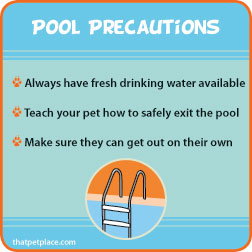 your dog to take a dip on hot days, teach him how to get out of the pool on his own by helping him up the stairs or ladder a few times. Make sure he knows where the way out is and that he can get out on his own! Keep fresh-chlorine free water near the pool on the deck or patio so he doesn’t take to drinking to pool water. The chlorine and other chemicals that keep the pool crystal clear can give your pet quite a tummy ache.
your dog to take a dip on hot days, teach him how to get out of the pool on his own by helping him up the stairs or ladder a few times. Make sure he knows where the way out is and that he can get out on his own! Keep fresh-chlorine free water near the pool on the deck or patio so he doesn’t take to drinking to pool water. The chlorine and other chemicals that keep the pool crystal clear can give your pet quite a tummy ache.
When Playtime is Done
When your day of fun is done, rinse or shampoo your dog to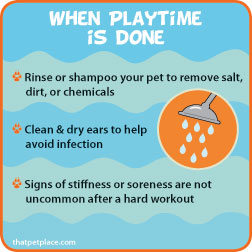 remove pool chemicals, salt and other residue from his skin and coat. Take care to clean and dry his ears to avoid ear infections. Even a well-conditioned swimmer will be sure to sleep well after a day in the water, your pet may even be a little stiff and sore if he doesn’t have a workout like that often. Rest assured that in a day or two he’ll be ready for his next swim session!
remove pool chemicals, salt and other residue from his skin and coat. Take care to clean and dry his ears to avoid ear infections. Even a well-conditioned swimmer will be sure to sleep well after a day in the water, your pet may even be a little stiff and sore if he doesn’t have a workout like that often. Rest assured that in a day or two he’ll be ready for his next swim session!
Common Pet Parasites and Pests – Warm Weather Worries
Parasites can afflict pets any time of the year, however during the spring and summer months, they tend to be more prevalent. Our pets spend a lot more time outside when the weather is warm, and parasites breed more readily. Even if your pets spend all or most of their time indoors, it is possible for parasites to find them whether carried in on our clothes or by crawling through our screen doors. Here are some common parasites to look out for and ways to combat them this summer. Read More »
July 4th Fun & Fireworks – Pet Anxiety & Safety Tips
The July 4th Holiday is upon us, and unfortunately it is one of the busiest times for animal shelters due to the overwhelming amount of dogs lost during the fireworks & festivities. The fireworks may be fun for us, for some of our canine friends it can be downright terrifying.
During fireworks displays, or even while setting off fireworks in your backyard and neighborhood, your usually calm family pet may become extremely stressed. The stress overload can cause some pets to try to escape the house or yard. By following a few simple tips for this holiday weekend you can avoid coming home to an empty house and the anxiety of a missing beloved family pet.
- Avoid bringing your pet to fireworks displays, even if they are not usually startled by loud noises or thunder.
- Keep your pet indoors in a quiet, safe, sheltered area. Keep doors and windows closed and locked (I’ve heard stories of dogs opening slider doors or even jumping through windows to escape). Leave the TV on or play soothing music at a normal level to distract him from the noise outside
- Prepare a safe “den” for your pet. If they choose to hide under the bed, in their crate or somewhere else in the house, allow them to. If your dog is not crate trained, and you would like him to be please visit our comprehensive crate training guide.
- Feed your pet before the displays begin and keep a special chew treat on hand as a distraction.
- Nervous or stressed dogs may chew to ease anxiety. Make sure to provide proper chew toys and make sure all cords and other dangerous objects are out of reach
- Try a calming aid to help calm anxiety, or ask your vet for medication to help with your pet’s noise phobia.
- Do not leave your pet outside during the festivities. Even with a fence or a tie-out a dog can go to great lengths to escape the source of their anxiety.
- Always make sure your pet is wearing a properly fitted dog collar with up-to-date ID tags. Consider having your pet microchipped for extra security.
- Try not to reward anxiety with extra attention. It may be hard not to cuddle or fawn over your pet when he is scared, but do your best to ignore axious behavior or practice distraction techniques to turn their focus away from commotions.
Follow these simple steps to enjoy a worry free Independence Day. The knowledge that your family pets are safe and sound will make your holiday all the more fun. Have a great holiday weekend!
Severe Weather can also be very stressful on our pets. Check out this post for tips on keeping you pets calm during severe weather.
How To Tell If Kittens Are Abandoned
Hello, my name is Tricia K. I currently own 3 cats, Bubba is 5, Firefly (aka Bug) is 3, and Scrappy is 7/8 months old. I have been volunteering for a rescue called “Lost Paws of Lancaster” for about 3 years, fostering for about 2 years. I have worked at That Fish Place – That Pet Place for almost 2 years as a cashier. I enjoy learning new things about all animals and applying what I learn to help others.
When you volunteer for a cat rescue, the season of spring is more commonly known as “Kitten Season”. This is the time of year that we begin getting phone calls asking us to take in pregnant or nursing moms and their litters of kittens. The more common call, however, is for “abandoned kittens.” I put quotes around it because more often than not the kittens aren’t really abandoned.
Unlike human children, who are rarely without a parent in sight, kittens can be left alone for hours at a time and the mom usually isn’t far off. In fact, mom may even be watching you. People often don’t realize this and tend to automatically assume that mom has left the litter to starve. They then decide to take things into their own hands and “help” which isn’t always in the best interest of the kittens.
How To Tell If Kittens Are Abandoned & Need Your Help
- Unless the kittens are in immediate danger, don’t move them. Mom may just be out getting some dinner, or taking a break. (You’d need to take a breather too if you had so many babies at once!). If you have to move them, make sure it is nearby where mom can see or hear them calling for her.
- Keep an eye on the nest from a distance for 12 to 18 hours to determine if they’re truly abandoned. Depending on how old the kittens are, moms can stay away for hours at a time. It can be hard to tell if mom slips in and out when you aren’t looking. A way to help tell if the mom has returned is to sprinkle flour around the area. If mom comes back she will leave paw prints in the powder.
- Don’t be alarmed if some of the kittens go missing. This is probably a good sign. Active Moms will move their kittens from place to place if they feel they are in danger.
- If hours pass and the babies are dirty, fussy and loud, it is safe to consider them abandoned. It’s important to remember to wait an appropriate amount of time and to stay calm. A lot of people panic and want to scoop the kittens up and care for them right away. However, caring for kittens, especially young ones that don’t eat solid food, is a lot of work that most people aren’t prepared to take on. It is also more dangerous for kittens growing up without a mom and the comfort and milk she provides. Whenever possible, keep mom in the picture.
What if Mom Doesn’t Return? What now?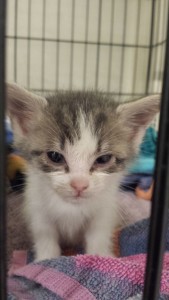
- If you have truly abandoned kittens, and you are not prepared to take on the responsibilities of motherhood, feel free to call your local rescues. Please keep in mind that kitten season is a very busy time of year. Rescues exhaust their resources very quickly and you may be declined. Fosters for bottle babies (kittens without mommas that cannot eat solid food yet) are always in short supply because they are a lot of work.
- If you are able to foster the litter the rescues may have a waiting list that you can be put on to help your kittens and lighten your load.
Even if the rescues can’t take in your litter they may have tips and tricks to make your go at being a momma cat much easier.
This Kitten season, Please be patient and do what you can to help appropriately. While it’s hard to resist a pile of adorable, cuddly kittens, letting Mom handle their care is sometimes the best option.
Bunny Proofing Your Backyard: Keeping Pet Rabbits Safe Outdoors
Please welcome guest blogger Tabitha Strepthorne. For our perusal, she has an informative article about letting your rabbit roam in your backyard. While exploring your backyard and garden can be a great source of fun and exercise, there are opportunities for your rabbit to get into harm’s way. She has some helpful tips and advice you can use to make sure your furry friend stays safe while still having a great time. If you have any questions, comments or your own ideas for bunny fun, please let Tabitha and us know in the comments section below. Have a great weekend!
________________________________
Whether you have a Netherland dwarf or an English Giant it is important to make sure that your pet rabbit gets the exercise he or she needs. Large, spacious hutches are great for keeping your rabbit in shape, and there are outside hutches available for sunny days. There are even rabbit harnesses that you can put onto the rabbit so that you can take your bunny for walks!
However from personal experience, some bunnies may not like the feel of the harness and they will chew through it. Often outside hutches can seem cramped. So what to do?
Why not make the entire garden your bunny’s exercise yard? If you have a colourful, green garden with a few nice patches of grass, it may be worth looking into bunny-proofing your garden. Unfortunately if you have a pond, chances are no amount of ‘bunny proofing’ will make it safe for your rabbit to run around the garden.
Fences and Gates
Bunnies are a lot like babies. If you take your eyes off them for a minute, somehow they will find their way into the strangest cubby holes, nooks and crannies. This is why it is important to ensure that any fences are fully staked into the ground, and that any gates have a rubber lining or a low hanging base to make sure that the rabbit doesn’t crawl underneath the gate and get out of the garden.
If you have decking it is important to board up any entrances to the decking, as if your bunny is at all adventurous they will try to find a way underneath. Beneath the decking is a great place for rabbits as it is dark and shady – perfect for the summer!
Harmful Plants
Most rabbits have an innate sense of danger and will be able to sniff out any potentially harmful plants. However rabbits have strong taste buds and can be curious, particularly young rabbits, so on occasion things can take a turn for the worse.
Certain plants are incredibly harmful to rabbits, so it is important to look these up online to make sure that your bunny is safe. A few examples of common plants that can be poisonous to rabbits are oak leaves, poppies and buttercups although a little bit of digging online will harbour a more complete list of poisonous plants.
Bedding and Water
 Bunnies can get nervous too! If you have a small garden and a young bunny, try placing some of its bedding in a corner of the garden. The bunny will gravitate towards the bedding as a source of familiarity and comfort, and as it gets more used to the feel of the garden the rabbit will then start exploring more and more of the garden.
Bunnies can get nervous too! If you have a small garden and a young bunny, try placing some of its bedding in a corner of the garden. The bunny will gravitate towards the bedding as a source of familiarity and comfort, and as it gets more used to the feel of the garden the rabbit will then start exploring more and more of the garden.
The most important thing is ensuring that your bunny feels safe and secure while running around the garden. Make sure to put a bowl of water out for your bunny in a shaded area as they will become dehydrated. Weigh the bowl down with a few stones so that your bunny doesn’t knock the water over by running past it or jumping over it.
It is important to remember that nothing is foolproof! Although your bunny will be able to run and play it is crucial that you supervise them to ensure that you can take any action needed if your bunny starts getting into trouble or starts acting out. Like a small child, stay close to your bunny and be aware! With a safely bunny-proofed garden your rabbit can hop and run around to their hearts content!
Dogs and Babies: Tips for Introducing Your Pet to Your Newborn
When my husband and I were expecting our first child, part of our preparations included getting Chester (our 6 year old hound dog) ready for the baby. We have all been told to bring something home from the hospital with the baby’s scent on it but did you know there are other ways you can help prepare your dog for their new little brother or sister?
Set Up The Stuff
Babies come with tons, and I mean TONS, of stuff. You can help your dog prepare by slowly putting the new items out. Set up your crib one day and then that fancy new swing or play mat a few days later. Take it slow and let him get used to each item before adding the next. Introducing these items gradually will give your dog a chance to smell and explore each one, and then when your baby arrives he will already be used to those things being in the house.
Bring Babies Around
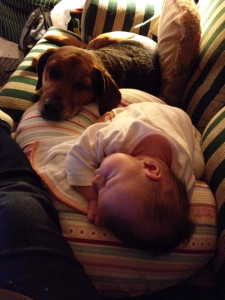
Have friends with babies? Have them over. If your dog has never been around a baby you may want to see how he reacts to the crying and all the new little movements. Some people have even used those electronic babies you were forced to bring home from health class. Lucky we have lots of family and friends with kids, so Chester has had exposure to children of all ages.
Set Boundaries
Let your dog know what’s okay and what’s not. If he won’t be allowed in the nursery after the baby comes, don’t let him in now. If you let him do things now that you won’t let him do when the baby arrives it’s going to confuse him and he could end up resenting you or your little one.
Tell Him About The Baby
Everyone says that dogs can tell when you are pregnant and I really believe that Chester knew. It might sound silly to a non pet owner, but I talk to Chester like he’s my best friend so naturally I told him all about his little sister before she arrived. I like to think he understood and that helped him prepare.
Stock Up On Treats And Toys
In the weeks after you bring your little one home your front door will be like one of those revolving doors at the mall, people coming in and out all the time. Chester is extremely food motivated, so we stocked up on lots of different types of treats. We got some of his favorite training treats to reward him for good behavior or if we needed to temporarily distract him from the door or other items. We also loaded up on some long lasting treats like Greenies , filled bones, and Indigo chews. These were good to have when he would get a little too excited and we needed to divert his attention for a longer period of time. If you are worried about over treating or your dog is on a diet, toys can also be used to keep your pup occupied.
Have A Plan
This may be common sense but make sure you have a reliable pet sitter on call. Child birth is unpredictable–you can go into labor at any time and be in the hospital for an undetermined amount of time. Make sure you have one, if not two, pet sitters that will be able to get your dog within a few hours when the big day comes.
Control The Introduction
Chances are that you haven’t seen your dog for a few days, so he is going to be really happy to see you. Give him a little time to get his excitement out and give you all the kisses he wants before bringing in the baby. What worked for us was to have my mom take Emmalynne into her nursery when my husband brought Chester home. Once he was over the excitement of seeing me he sniffed around at the diaper bag and car seat then we took him in to meet his little sister.
Keep Calm
Your dog can tell if you are nervous and that can make him uneasy, if you stay calm and don’t make a huge deal out of him meeting the little one he won’t either. Remember to take it easy on your pup; this is a huge adjustment for him too. Dog toys and baby toys are surprisingly similar so you can’t really blame him for chewing on one you leave out.
Don’t Forget Your Dog
Make sure your dog gets enough exercise and attention. Try to stick with his normally scheduled feedings and walks; you don’t want to have to deal with accidents just because you didn’t have time to let him out. We take Chester with us everywhere that we are allowed to. So even though it might be easier to leave him home sometimes, we make sure that if we would have taken him before Emmalynne was born, we take him now. I look at it more like; we now have two kids rather than one kid and a dog.
These are some of the things that helped Chester make the transition from only child to older brother. Emmalynne is now two months old and Chester has taken on the role of her protector. When someone new holds her he is watching their every move. He is more alert and curious about abnormal noises. In the mornings when she’s in our room sleeping and I’m getting ready he lays in the doorway where he can keep an eye on both of us. It makes me feel good knowing that he is looking out for her (as all big brothers should). I think he has accepted her as a member of our family and I am excited to see how their relationship grows as she gets older!
Holiday Dangers: Poisonous plants popular during the holiday season
 Nothing quite ruins the holiday spirit like a trip to the emergency vet… especially for something that could have been avoided. There are tons of plants that are poisonous to your pets that are available year-round (view the full list on the ASPCA website), but around the holidays many of these popular but poisonous plants seem to be in every home!
Nothing quite ruins the holiday spirit like a trip to the emergency vet… especially for something that could have been avoided. There are tons of plants that are poisonous to your pets that are available year-round (view the full list on the ASPCA website), but around the holidays many of these popular but poisonous plants seem to be in every home!
Do yourself, your vet, and your pet a favor and keep these poisonous holiday plants out of your home or safely out of reach of your pets!
Poinsettia
Many people know that poinsettias as toxic, however they are really only mildly toxic and aren’t too big of a concern for most pet owners, but better safe than sorry. To be on the safe side I always leave mine in the office instead of in my home. I really love this festive plant… But I love my furry family more.
Signs to watch for: Irritated mouth and stomach or vomiting.
Mistletoe
Ah, to be kissed under the mistletoe… by my dog (hehe). If you have a spring of live mistletoe in your home, please keep it well out of reach of your pets. Along the same lines as the Poinsettia, this plant is now thought to be mildly toxic, but I like to play it safe.
Signs to watch for: Gastrointestinal distress, cardiovascular collapse, dyspnea, bradycardia, erratic behavior, vomiting, diarrhea, or low blood pressure.
Holly
Holly berries are very pretty, but they’re also attractive to dogs. This seasonal plant can cause symptoms that are similar to when a dog eats chocolate or caffeine. The bark, leaves, berries and seeds are all poisonous.
Signs to watch for: Vomiting, diarrhea and depression/lethargy.
Amaryllis
Amaryllis plants are toxic to both dogs and cats. These bulbs are typically given as gifts this time of year. If you’re buying for a friend with a pet, pick a pet-friendly plant over this pretty bulb.
Signs to watch for: Vomiting, depression, diarrhea, abdominal pain, excess salivation, anorexia, and tremors.
Pine Needles
While not exactly toxic to your pets, you will want to keep your pet from eating pine needles from the tree or the floor. Pine oils can irritate the mouth or stomach and if swallowed the needles themselves have the potential to puncture the lining of the stomach or intestines. Play it safe and sweep up those excess pine needles or put a barrier around the tree. Better yet, go for the old fake tree and save yourself the hassle of picking up needles for the next 6 months!
Signs to watch for: gastrointestinal distress, lethargy, irritated mouth and stomach.
Of course, if your pet has ingested any of these plants, please contact your local veterinarian, your emergency vet or the ASPCA Animal Poison Control Center at 888-426-4435.
 That Pet Blog That Pet Place Pet Blog
That Pet Blog That Pet Place Pet Blog

